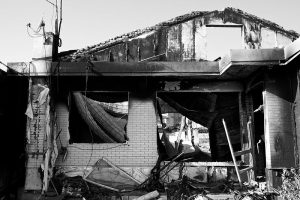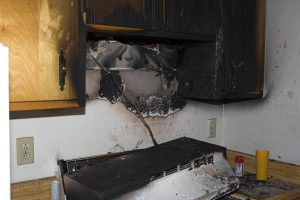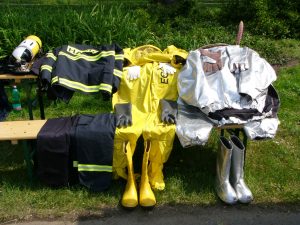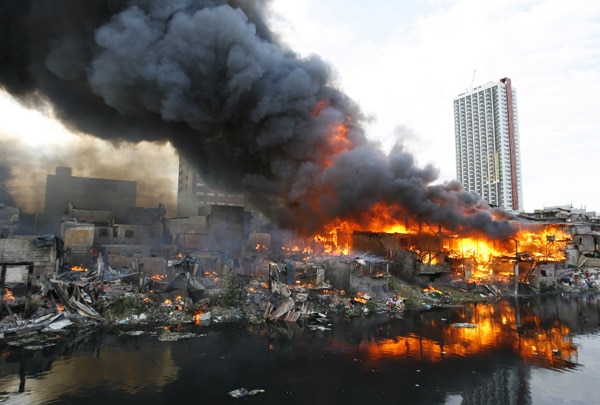One Of The Best Online Guides To Help You With Fire Damage

Fires may be the worst disaster you and your property can suffer, because they cause both severe physical and emotional damage. One day you are going about your usual routine – the next, you’ve lost some (or all) of your home and valuables. As with any adverse event in life, there’s really no choice but to pick yourself up and get on with the process of putting your life back in order, no matter how difficult it may be. This ultimate DIY fire damage cleanup and restoration guide is meant to help you along the road to recovery.
Not A Normal Do-It-Yourself Project
Restoring a property after a fire is a major operation. You can do it yourself, but it is critical to understand that there’s a complicated step-by-step process which must be followed, and it involves a ton of work. For a few people with the energy and home repair ability to dig in and keep going, it can be a good way to take their mind off a devastating loss. For most, however, fire damage cleanup and restoration is simply too much, too soon. If you prefer to use a professional service, Action 1 Restoration is ready and able to take care of every detail for you. If you prefer to handle the work on your own, then this step-by-step guide will help you get things back in order.
Always Remember, Safety Comes First

The biggest safety issue typically involves cleaning and other poisonous liquids kept in the home. If you have a kitchen fire, the products you use to clean are going to be damaged and may leak all over the floor. A mixture of bleach, Windex, drain cleaner or similar liquids can create an acidic cocktail which could cause second or third degree burns. Materials often stored in the garage like paint thinner, and even your electronic components, can also become toxic when damaged by a fire.
To avoid health risks, you need proper safety attire:
Waterproof boots
- A body suit made from plastic
- A breathing mask
- Goggles
- Industrial strength cleaning gloves
This may sound like overkill, but consider the health problems which emergency personnel experienced in New York after the 9/11 tragedy: sinus problems, new-onset asthma, declines in pulmonary function, gastroesophageal reflux symptoms, sarcoidosis and increased cancer risk.
Particulate debris in the air and on practically every surface can be a serious health risk as well. Do not take this risk lightly. Protect yourself to avoid turning a property damage issue into a serious or even life-threatening health problem.
Breaches
Once fire officials allow you back into your home, the first step is to determine if you have any breaches in the structure. A breach is an area where a section of the roof or a wall is missing, exposing the interior of the home to the elements.
Breaches caused by fires should be sealed immediately. If they are not, there are two potential problems which can arise:
- Secondary Fire – the wind, or even a breeze, can cause embers to flare up and start a secondary fire. Firemen will do their best to put out every ember, but it’s easy to miss a few and one is all it takes.
- Rain and Humidity – If you live in an area which gets rain or high humidity (and most areas do), a breach in the structure can result in mold, rot and damage to sensitive property such as computers.
The best method for addressing a breach is to place a tarpaulin over it to seal out the elements. The tarp needs to be made of rugged material, and attached so that it creates an effective seal. If rain is a potential problem the tarp needs to be supported so that water can’t pool on it, because water weight could easily cause the protection to fail.
Water Removal
As odd as it may sound, water is a real problem with fires. Firemen working to save your property will pump hundreds or thousands of gallons of water onto your home to extinguish the blaze. Some of that water will evaporate because of the heat, but a good amount of it is going to pool on the ground. There it will mix with burned plastics, spilled liquids and other potentially dangerous substances. All of this water must be removed before you start addressing the actual fire damage. Don’t forget to check your basement, which might be filled with sooty water as well.

You will need two basic pieces of equipment. The first is a water pump with hoses which can move large amounts of water. You are looking for the maximum pumping power you can afford, so ask for guidance from sales representatives at the store.
You are also going to need a press extractor. This device pushes down on carpets and then sucks up the water which has been soaked up by the material. If you are lucky, you might be able to save the carpet. Usually you won’t be that lucky and will need to replace the carpet. You’ll still need an extractor, though, because the weight of a soaked carpet is staggering and you will have a very hard time removing it from your home if it’s still waterlogged. If you have hardwood floors, you may avoid the need for a press extractor – but the floors may have buckled and warped from the water and they may need to be replaced.
Categorizing and Soot Removal
With the water removed from your property, you can finally get on with categorizing the damage caused by the fire. To do this, you will first need to remove the soot that’s accumulated everywhere, so you can accurately determine the level of damage and whether an item can be restored or should be trashed.
Soot is the black substance left by the smoke from a fire. A major difficulty in cleaning soot is that it tends to have an oily base because of plastics which have burned. That problem usually prevents you from simply wiping soot off surfaces with a rag. Instead, you need a cleaning agent to do the job, and the best is trisodium phosphate cleaner. (You can find an example of it here) You may have never heard of it, but you can use this degreaser to remove soot fairly easily. It’s available at all big box hardware stores; when you’re there, use this shopping list for cleaning soot:
- trisodium phosphate cleaner
- large buckets
- sponges
- large, heavy-duty trash bags

Kitchen Fire Damage
Soot gets onto everything and just about everywhere, so plan on going through a ton of sponges and trash bags for this do-it-yourself effort. Fortunately, a little trisodium phosphate goes a long way. Consult the instructions of the particular brand of cleaner you purchase, but you usually need to mix a tablespoon of trisodium phosphate with a gallon of water. Here is some additional cleanup help and tips that can help you, visit this website.
Once you have the phosphate mixed, it is time to get to work. Start at one end of the fire-damaged area and methodically move to the other end. Being sure to wear your safety equipment, clean and examine items for damage. If you have insurance, make sure to snap a picture of each item for the insurance claim.
Be objective and smart when examining fire-damaged items. Anything which is cheap, like a book or DVD, should be photographed and then tossed in the trash unless it is a rare edition. Don’t get caught up in reminiscing or it will take weeks for you to work through the mess. Just quickly clean, analyze and categorize items as either salvageable or ruined.
Once you’ve gone through all of the small items, it’s time to review the furniture. Burned pieces should, of course, be trashed. But close attention must be paid to “undamaged” furniture which badly smells of smoke. It may need to be trashed as well, particularly if it has been soaked with water, because it could be a fertile growing spot for mold.
At this point you should be looking at an empty room, so it’s time to examine the flooring. If you have carpet which is damaged or soaked, you should call in an expert to see if it can be saved. Wet carpets act as a Petri dish for bacteria and mold so most soaked carpets must be tossed. Still, it is worth taking the time to see if yours can be saved unless, of course, your insurance will cover its replacement.
If the carpet must be thrown away, pull it up from the foundation and roll it into the smallest sections possible; your back will thank you for taking this step, because carpet is extremely heavy. Haul the carpet out of the house and take it to a dump for disposal.
It is virtually impossible to “fix” badly buckled or warped hardwood flooring by yourself (if at all), so if you’re confronted with that issue you’ll probably need to consult an expert.
Walls, Ceiling and Foundation
The fire-damaged areas of your home should now be “naked” with no furniture, flooring or other items in the room. There should just be hard flooring, blank walls and ceilings.

Fire and Smoke Damage Repair
Slowly walk around the damaged area inspecting the under flooring or concrete for damage. Cracks with water seepage are a particular concern. If water gets into the foundation, it will expand and contract as seasons change, slowly expanding the cracks. This can lead to foundation damage or failure, which is incredibly expensive to repair. Even if it has been repaired, many home buyers will refuse to make an offer on a property once they find out it has had foundation problems in the past. If you see cracks, contact a foundation specialist to get his opinion on what to do next.
If the foundation is in good shape, the next step is to break out the trisodium phosphate cleaner again. Mix up a batch and start walking through the house removing soot from the flooring, walls and ceiling. It is critical that you take your time to get every little spot, or you could end up with an odor of smoke which will never go away. Depending on the size of the fire-damaged area, it could take a few days to complete this part of the cleaning.
Eliminating That Smoke Smell
Trisodium phosphate is an amazing product for removing soot, but it usually doesn’t remove all of the smell after a fire. We strongly recommend a few additional steps.
The first is to use white vinegar to wipe down any area where smoke was present. Vinegar is a versatile liquid, and one thing it does particularly well is kill odors. Do a full wipe of the floor, walls and ceiling to lessen the risk of permanent smoke odor.
Here is some good cleaning uses for white vinegar.
Here is 6 household items you should not clean with white vinegar.
Second, change out all the filters in your heating and air conditioning systems. You may even need to do a thorough cleaning of all your ducts or even replace your air conditioning ducts all together. Soot particles are unquestionably embedded in those filters or air ducts, so you run the risk of introducing the odor to the structure every time you turn your heat or A/C on.
Third, consider setting up a small Japanese “sand” garden in rooms which were damaged in the fire. In this case, however, you are going to use activated charcoal or baking powder instead of sand. Both naturally absorb odors, which can take care of any residual smoke smell. If a sand garden isn’t your thing, get creative and find a way to place either of these odor-absorbing materials in the room.
At this point, you are ready to actually restore the impacted areas. Set a budget for the work to be done, determine the materials to be used and then start building.
Be Ready For A Long, Tough Job
If you’ve made it all the way through – congratulations. Cleanup and restoration after a fire sounds like a ton of work, because it is. Even the most motivated do-it-yourselfers are often daunted by the process of recovering from a fire, particularly because it can be difficult and depressing to go through all of your ruined valuables. We’re not suggesting that cleanup and restoration after a fire is impossible. You can do it. Just realize this is much more than a “weekend job.”
If you decide to use a professional service which can get to work quickly and do the job expertly, Action 1 Restoration is ready to take the burden off your shoulders. Just visit one of our locations to call us now, day or night we are available to help you. And if you’d rather try to do it yourself, you can always call us if you get stuck or discouraged partway through the project.


 Waterproof boots
Waterproof boots